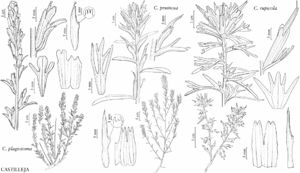Castilleja rupicola
Erythea 6: 45. 1898.
Herbs, perennial, (0.8–)1–2(–3) dm; from a woody caudex; with a taproot. Stems many, decumbent to ascending, unbranched, sparsely pubescent, hairs spreading, wavy, fairly short, soft, eglandular, sometimes glabrous proximally. Leaves purple to green, narrowly, rarely broadly, lanceolate, 1.4–4 cm, not fleshy, margins plane, flat to involute, (0–)3–5(–7)-lobed, apex acute to acuminate; lobes divergent, spreading-ascending, linear, long, not much narrower than mid blade, often with secondary lobes, creating little frilly fans, apex acute or obtuse. Inflorescences 2–6 × 2–3.5 cm; bracts proximally greenish or deep purple near base, distally red, scarlet, or crimson to red-orange, rarely orange, salmon, pink, or yellowish white, ovate to orbicular in outline, 5(–9)-lobed; lobes spreading, linear to linear-lanceolate, long, arising below mid length, apex acute to rounded. Calyces proximally purple, green, or whitish, distally colored as bract lobes, 15–25 mm; abaxial and adaxial clefts 8 mm, ca. 40–50% of calyx length, deeper than laterals, lateral 1–5 mm, 10–20% of calyx length; lobes triangular, apex obtuse or acute. Corollas straight or slightly curved, 25–35(–45) mm; tube 9–15 mm; beak exserted, adaxially green, purplish, or yellow-green, 14–22 mm; abaxial lip deep green, reduced, 0.5–2 mm, 6–12% as long as beak; teeth incurved to erect, green, 0.5 mm.
Phenology: Flowering (May–)Jun–Sep.
Habitat: Sunny rocky slopes, scree, talus, ledges, fellfields, subalpine to alpine.
Elevation: (200–)1000–2500 m.
Distribution
B.C., Oreg., Wash.
Discussion
Castilleja rupicola is usually found in the subalpine and lower alpine zones in the Cascade Range from extreme southern British Columbia south to northern Douglas County, Oregon. Though it can be numerous where it occurs, the species as a whole is uncommon. One atypical population occurs in a moist, shaded, mossy, north-facing ravine on the Oregon side of the Columbia River Gorge, at less than 250 m. These plants often bear secondary divisions on deeply dissected leaves and bracts.
Selected References
None.
